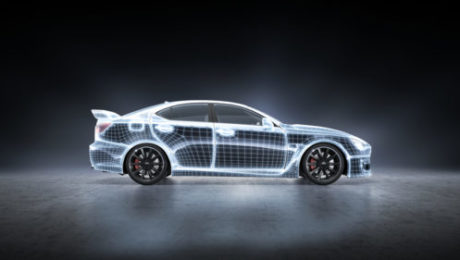Understanding Auto Liability Coverage
This article is from RISQ Consulting’s Zywave client portal, a resource available to all RISQ Consulting clients. Please contact your Benefits Consultant or Account Executive for more information or for help setting up your own login.

Auto insurance is one of the most frequently purchased types of coverage in the United States. However, while these policies may be common, they can still be complex and nuanced. Policyholders must be diligent and meticulous to ensure they fully understand their auto coverage and have ample financial protection.
One of the most common and crucial components of an auto insurance policy is adequate liability coverage. Any time a driver gets behind the wheel, they risk being involved in accidents that could harm others and incur devastating financial consequences. This article provides an overview of auto liability coverage and its importance.
What Is Auto Liability Coverage?
The liability portion of auto insurance is strongly advisable and is usually required by law. Although minimum requirements may vary among states, all drivers are generally mandated to carry certain liability coverage to ensure they can pay for losses for which they are at fault.
Liability coverage can insulate drivers from significant losses affecting third parties, including the following:
- Bodily injury—If a policyholder is responsible for an accident that injures another party, such as a pedestrian or occupants of another vehicle, this coverage can help pay resulting expenses, such as:
- Medical bills
- Lost wages
- Legal expenses
- Property damage—If a policyholder is at fault for damaging someone else’s property, such as by colliding with another vehicle or crashing into a building, this coverage can provide financial assistance to compensate affected parties and pay for costs arising from resulting lawsuits.
Most auto insurance includes three separate liability limits within a policy. These clauses establish the maximum amount of financial aid capable of being covered and generally are listed as the following:
- Bodily injury liability limit per person
- Bodily injury liability limit per accident
- Property damage liability limit
Another type of coverage that could help you financially protect yourself in an accident is uninsured/underinsured motorist coverage. This coverage, which is sometimes sold separately as uninsured motorist coverage and underinsured motorist coverage, can often be added to your personal auto insurance policy to help you avoid high out-of-pocket costs if you’re involved in an accident with a driver who doesn’t have any liability coverage (uninsured motorist coverage) or doesn’t have enough liability coverage (underinsured motorist coverage).
Ensuring Adequate Coverage
Motorists should consult with a qualified insurance professional to understand applicable auto insurance requirements. Failing to comply with relevant laws could lead to significant fines and legal penalties. Their lender may also require those who purchased their vehicles with the help of an auto loan to adhere to additional requirements.
Even if not mandated to do so, carrying sufficient auto liability coverage is strongly advisable. Without suitable insurance, an accident could lead to devastating out-of-pocket costs that jeopardize a driver’s financial situation.
It’s also essential to understand the limitations of auto liability coverage, which should not be relied upon to cover a policyholder’s own losses. Such financial assistance generally must be acquired through including additional coverages in an auto insurance policy, such as the following:
- Collision coverage—This may help pay for damage sustained by a policyholder’s vehicle resulting from striking another car or stationary object (e.g., building, fence, tree)
- Comprehensive coverage—This may provide coverage for incidents not included in collision coverage, such as fires, crime and severe weather.
- Medical payments coverage—This may provide financial assistance for a policyholder and their passengers if they are injured in an accident, regardless of who was at fault.
Making Sure You’re Covered
Auto liability coverage is an essential form of financial protection for any person who owns or operates a motor vehicle. For more information or guidance regarding optimal auto insurance solutions, contact RISQ Consulting today.
- Published in Blog
AAA Says Bad Driving Worsened Last Year
This article is from RISQ Consulting’s Zywave client portal, a resource available to all RISQ Consulting clients. Please contact your Benefits Consultant or Account Executive for more information or for help setting up your own login.

Drivers increasingly engaged in dangerous behaviors last year. According to new survey data from the AAA Foundation for Traffic Safety, this put the brakes on a three-year decline in speeding, driving under the influence, and texting while driving.
The foundation found widespread increases in bad driving habits in 2021, but “most alarming” was a nearly 24% year-over-year uptick in the number of people who admitted to getting behind the wheel after drinking too much. A total of 7.3% of those surveyed admitted to driving under the influence of alcohol.
Those admitting to excessively speeding increased by 12.4% to nearly 51%, and those who said they drove within an hour of consuming cannabis rose by 13.6% to 5% of all people surveyed.
“The reversal in the frequency of U.S. drivers engaging in risky driving behavior is disturbing,” David Yang, the foundation’s executive director, said in a statement. “While drivers acknowledge that certain activities behind the wheel – like speeding and driving impaired, are not safe, many still engage in these activities anyway. We must be aware of the serious consequences of dangerous driving behaviors and change course.”
More than a quarter of those surveyed admitted to texting while driving in the past 30 days, even though 92% acknowledged doing so is dangerous. And while 88% of people agreed that aggressive driving behaviors, such as quickly changing lanes, is hazardous, nearly 23% admitted to driving aggressively within the past 30 days.
Insurance industry observers have noted the especially poor performance of personal auto lines of late is partly due to unsafe driving. Driving behavior worsened with the onset of the pandemic, coinciding with a decrease in overall miles traveled, and has not improved as traffic volumes normalized. Other factors cutting into personal auto profitability include supply chain disruptions, increasing costs of vehicles and replacement parts, and a shortage of skilled mechanics.
- Published in Blog
Electric Vehicles Present New Insurance Challenges
This article is from RISQ Consulting’s Zywave client portal, a resource available to all RISQ Consulting clients. Please contact your Benefits Consultant or Account Executive for more information or for help setting up your own login.

Electric vehicles (EVs) continue to gain traction in the U.S. auto market. Last year, Americans bought nearly 450,000 EVs—an 83% jump over 2020. With many federal and state governments pushing for lower CO2 roadway emissions, EV demand is expected to soar during the next decade.
This has commercial fleet owners wondering what a world without gas- and diesel-powered vehicles might look like, particularly when it comes to the potential exposures EVs could create. This article discusses the risks that could impact insurance costs for EV fleets.
Unique EV Risks
Because EVs tend to cost more than standard automobiles, their insurance rates are usually higher. However, other factors unique to EVs could also make insuring them costlier. Such factors include:
- Cyberthreats—Like most new cars and trucks, EVs offer connected car technologies such as Wi-Fi, data sharing and semi-autonomous systems that leave them vulnerable to cyberthreats. However, the public charging stations EVs rely on to recharge their batteries add another layer of risk. Charging stations may serve as an entry point for malware attacks, data theft, system outages, bugs and glitches. What’s more, once a data breach occurs in a single vehicle, it may be easier for a malicious party to access the rest of the fleet.
- Battery problems—There are several risks associated with EV batteries that can potentially impact commercial fleets. For example, battery manufacturing defects can lead to large-scale vehicle recalls, putting fleet owners at an increased risk of business delays. Additionally, under certain conditions, lithium-ion batteries that power EVs can ignite or explode. Notably, battery fires burn longer and hotter, release more toxic fumes and liquids, and spread faster over a larger area than traditional fires. Such an incident would create a whole new set of insurance challenges.
- Pedestrian accidents—One selling point of EVs is they run quieter than gasoline-powered vehicles. Unfortunately, this lack of audible engine noise may also put pedestrians at greater risk of being hit if they fail to hear an approaching EV.
Other Considerations
While uncertainty about new EV technologies will likely drive up insurance premiums initially, expectations are that prices will stabilize over the long term. Meanwhile, several other concerns will need to be addressed before EVs become scalable. These include the following:
- Scarcity of repair shops and parts—Very few auto shops can handle EV repairs, so it may be difficult to find timely service. Further, shops that do fix EVs often have trouble locating parts. This is partly because four key elements essential to battery technology—cobalt, graphite, nickel and lithium—are currently in short supply. Even if supplies can eventually catch up with surging demand, EV auto shops will remain at risk for supply-chain delays, as these rare elements are sourced from distant regions all over the globe.
- Costlier repairs—Most EV parts cost significantly more than parts for gas-powered vehicles. Batteries are especially high-priced and vulnerable to harm. An accident that might be a fender-bender on a standard car could result in an EV’s total loss if the battery takes serious damage. Adding to costs, EV repairs usually require more labor hours. This is in part due to EV technology’s increased complexity as well as auto mechanics dealing with the learning curve of working on unfamiliar machinery. As a new generation of technicians gains experience, repair times should shorten.
- Extreme weather concerns—It’s unclear how much of a role extreme weather will play in EV battery performance. Under severely hot temperatures, batteries, on rare occasions, have been known to ignite or explode. Under cold temperatures, batteries hold their charges for a shorter period of time. However, it’s unknown whether these drawbacks are significant enough to make EVs impractical in certain weather conditions or climates.
- High voltage hazard—A number of high-voltage electric cables run throughout the body of EVs. When an accident occurs, exposed cables could cause serious injury to passengers or first responders trying to free crash victims from damaged vehicles.
Conclusion
Although it probably won’t happen overnight, EVs seem positioned to dominate roadways sometime in the near future. Commercial fleet owners who start thinking about EV insurance challenges today will be better positioned to thrive in a post-fossil-fuel landscape.
Contact us today to learn more about insurance for EVs.
- Published in Blog
General Cybersecurity Best Practices for Modern Vehicles
This article is from RISQ Consulting’s Zywave client portal, a resource available to all RISQ Consulting clients. Please contact your Benefits Consultant or Account Executive for more information or for help setting up your own login.

Modern vehicle technology has transformed in the past several years as autonomous driving, vehicle electrification and car connectivity features have become more common. While these digital innovations in the automotive industry have added significant customer value, they have also exposed vehicles to cybercriminals attempting to gain access to critical in-vehicle electronic units and data. This article discusses cybersecurity threats modern vehicles face, the importance of the automotive industry providing protections against those risks and best practices for minimizing cybersecurity threats.
Cybersecurity Threats in Modern Vehicles
These days, vehicles are becoming increasingly dependent on connectivity and technology that runs complex software. There are about 100 million lines of software code in today’s vehicles, and by 2030, they’re expected to have roughly 300 million. The overabundance of complex software code within vehicles offers ample opportunity for cyberattacks.
Cyberattacks on modern vehicles could endanger vehicle inhabitants and others, and they may also be used to track vehicles or related data. Hackers can accomplish these attacks through physical or remote avenues:
- Physical access—When hackers gain physical access to a vehicle’s internal communication system, they can affect vehicle operations, such as steering, acceleration and braking.
- Remote access—Modern vehicles utilize Bluetooth technology, remote start applications and GPSs. Once hackers gain remote access, they can transfer knowledge from computers to vehicles and vice versa.
Importance of Cybersecurity in Modern Vehicles
While in-car cybersecurity threats are still relatively new, they are an ongoing concern. It is now the responsibility of automakers to consider cybersecurity an integral part of their core business functions and development efforts. Systems and components that govern vehicle safety features must be protected from harmful attacks, unauthorized access, damage or other threats that might interfere with safety functions.
Best Practices
A layered approach to vehicle cybersecurity can help reduce the probability of an attack’s success and mitigate the ramifications of unauthorized system access. The following are general best practices for modern vehicle cybersecurity:
- Leadership priority on product security—An emphasis on mitigating cybersecurity challenges associated with motor vehicles and motor vehicle equipment should be a priority for automotive industry suppliers and manufacturers. By stressing the importance of cybersecurity from the leadership level down to the staff level, corporations can emphasize the seriousness of managing cybersecurity risks and prioritize cybersecurity throughout the product development process.
- Vehicle development process with explicit cybersecurity considerations—The entire lifecycle of a vehicle—conception, design, manufacture, sale, use, maintenance, resale and decommission—should be taken into consideration when addressing cybersecurity risks, especially since there is more flexibility to design and implement protective measures early in the development process.
- Information sharing—In late 2014, the National Highway Traffic Safety Administration (NHTSA) encouraged the automotive industry to establish Auto-ISAC, an industry-driven community for sharing and analyzing intelligence about emerging cybersecurity risks to vehicles. Vehicle manufacturers, automotive equipment suppliers, software developers, communication services providers, aftermarket system suppliers and fleet managers are strongly encouraged to join Auto-ISAC and share timely information concerning cybersecurity issues.
- Security vulnerability reporting program—Members of the automotive industry should make information reporting easy for the security research community and the general public to help identify cybersecurity vulnerabilities.
- Organizational incident response process—While it’s not possible to predict all future attacks, organizations can prepare their responses, processes and staff to handle incidents effectively. Organizations should develop a product cybersecurity response process that includes:
- A documented incident response plan
- Roles and responsibilities that are clearly identified within the organization
- Communication channels and contacts outside of the organization that are clearly identified
- Procedures for keeping information up to date
- Self-auditing—To establish a clear and controlled process for managing software and related vulnerability risks, organizations must ensure documentation and document controls are in place. For process management documentation, members of the automotive industry should:
- Document the details related to their vehicle cybersecurity risk management process
- Retain documents through the expected lifespan of the associated part
- Implement and follow a control protocol
To assist companies in better understanding their cybersecurity practices and how to improve them, procedures for internal management and documentation review should also be established.
- Education—Continuous education of existing and future workforces can assist in improving the cybersecurity of motor vehicles. NHTSA encourages vehicle manufacturers, suppliers, universities and other stakeholders to work together to support the educational efforts of the workforce.
- Aftermarket/user-owned devices—Aftermarket devices, such as insurance dongles, and user-owned devices, such as cellphones, could present unique cybersecurity challenges. Before these devices are connected to vehicle systems through interfaces provided by the manufacturer, they should be authenticated and provided with appropriate, limited access.
- Serviceability—The average motor vehicle requires regular maintenance and occasional repair to operate safely. The automotive industry should consider the serviceability of vehicle components and systems since vehicles can remain in use for over a decade.
Conclusion
The automotive industry can work towards protecting electronic systems, communication networks, control algorithms, software, users and underlying data from malicious attacks, damage, unauthorized access or manipulation by implementing cybersecurity best practices. Contact us today for more risk management guidance.
- Published in Blog





